https://www.youtube.com/watch?v=GLsODH-tS4E
https://www.youtube.com/watch?v=GLsODH-tS4E
Barbara Spindel in The Christian Science Monitor:
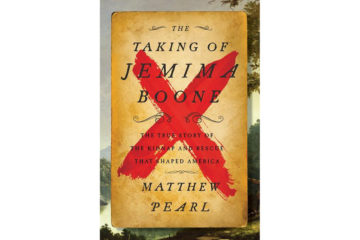 “An argument without end” is how Joseph J. Ellis characterizes history in “The Cause: The American Revolution and Its Discontents, 1773-1783,” one of several notable fall releases on America’s Revolutionary War era. Like “The Cause,” new works by historians H.W. Brands and Woody Holton and novelist Matthew Pearl, making his nonfiction debut, are evidence that when it comes to the story of America’s origins, the argument continues to evolve. These books look beyond the Founding Fathers to consider early American history from a fascinating range of perspectives.
“An argument without end” is how Joseph J. Ellis characterizes history in “The Cause: The American Revolution and Its Discontents, 1773-1783,” one of several notable fall releases on America’s Revolutionary War era. Like “The Cause,” new works by historians H.W. Brands and Woody Holton and novelist Matthew Pearl, making his nonfiction debut, are evidence that when it comes to the story of America’s origins, the argument continues to evolve. These books look beyond the Founding Fathers to consider early American history from a fascinating range of perspectives.
The title of Ellis’ engaging military and political history derives from the name that the colonists gave their rebellion against the British Empire. The conflict was not, at first, referred to as a revolution: The colonists’ original demands, to be accorded their full rights as British citizens, were hardly revolutionary. The changing meaning of The Cause, which eventually came to encompass independence, was reflected in Thomas Paine’s visionary and transformative 1776 pamphlet “Common Sense,” which shifted the conversation from British rights to natural rights.
The author deftly examines how that broader meaning, with its expansive view of freedom and liberty, could coexist with the denial of the rights of enslaved people and Native Americans. The American republic, he observes, “was born betraying the principles it claimed to be founded on.”
More here.
Steven Novella in NeuroLogica:
 What do economics, biological evolution, and democracy have in common? They are all complex adaptive systems. This realization reflects one of the core strengths of a diverse intellectual background – there are meaningful commonalities underlying different systems and areas of knowledge. In fact, science and academia themselves are complex adaptive systems that benefit from diversity of knowledge and perspective. All such systems benefit from diversity, and suffer when that diversity is narrowed, possibly even fatally.
What do economics, biological evolution, and democracy have in common? They are all complex adaptive systems. This realization reflects one of the core strengths of a diverse intellectual background – there are meaningful commonalities underlying different systems and areas of knowledge. In fact, science and academia themselves are complex adaptive systems that benefit from diversity of knowledge and perspective. All such systems benefit from diversity, and suffer when that diversity is narrowed, possibly even fatally.
A recent collection of studies focuses on American democracy as a complex adaptive system, and explores the mathematical underpinnings of how democracies behave and change over time in response to specific variables. Some of the insights are not surprising, but the research adds mathematical rigor to these phenomena. For example, you will likely not be surprised to learn that social media echochambers (what they call “epistemic bubbles”) lead to increased polarization of political views. But how, exactly, does this happen? What various researchers found is that when we obtain our political news from a network of like-minded people several things happen. First, the group tends to narrow over time in terms of political diversity. This happens because those who are considered “not pure enough” are ejected from the network, or leave because they feel less welcome. Further, people within the network tend to get access to less and less political news total, and the news they are exposed to is increasingly polarized. This doesn’t happen when such networks do not routinely share political news to begin with.
The core problem, therefore, seems to be the diversity of sources of information. Similar networks of people, in fact, can have a moderating effect on individual members, if the group maintains a diversity of sources of information reflecting a diversity of political opinions. Further, a healthy moderating effect is supported by individual members exploring outside the group for sources of information.
These patterns follow similar mathematical trends to other very different phenomena in other complex adaptive systems. For example, such trends tend to be non-linear, meaning the more extreme they get the more the trend accelerates. Further, there seems to be tipping points of no return. Once such information networks are radicalized beyond a certain point there may be no way back. Their models indicate that Republicans are likely already beyond this tipping point, while Democrats are rapidly approaching it.
What, then, can be done?
More here.
My wife sits reading in a garden chair
Pope’s Moral Essays by the failing light,
As Leaves turn epileptic in the air
And through the woods some poachers, and the night.
Pope’s natural habitat: a bullet rips
The homespun silence and the volume slips,
But catching it she finds her place in time
And never drops the stitches of a rhyme.
Braving the season in the name of wit,
She holds each couplet in such close esteem
No maniac can put a hole in it.
The year’s in tatters, but she makes a seam;
The house is civil, though the wood’s insane,
And man’s the missing link who lets the chain-
Of-being shake. It’s hanging by a hair.
My wife is reading in a garden chair.
by Barry Spacks
from Strong Measures
Harper Collins, 1986
Delia Falconer in the Sydney Review of Books:
 For Ghosh, our insistence on carrying on as normal in the face of the unthinkable is the enabling madness at the centre of modernity’s addiction to extraction and consumption. At a time in which ‘the wild has become the norm,’ and ‘freak’ events such as tornadoes are becoming more common, he wrote, we are suffering in the ‘West’ from a ‘crisis of imagination’.
For Ghosh, our insistence on carrying on as normal in the face of the unthinkable is the enabling madness at the centre of modernity’s addiction to extraction and consumption. At a time in which ‘the wild has become the norm,’ and ‘freak’ events such as tornadoes are becoming more common, he wrote, we are suffering in the ‘West’ from a ‘crisis of imagination’.
American-based Ghosh—academically trained with a doctorate from Oxford in anthropology—is an eloquent synthesiser and his book, which began as a series of 2015 lectures for the University of Chicago, drew on many of the major ideas bubbling in this field. Historian Dipesh Chakrabarty was the earliest to lay out, in a ground-breaking 2009 paper, the potential of this new epoch, in which human activity has become the planet’s driving force, to also destabilise the very pillars of humanist thought, incuding the distinction between natural and human history. Philosopher Tim Morton had written about the sticky unthinkability of huge changes like global heating across time and space; while other writers, like Robert Macfarlane had described the uncanniness of our moment as once long-scale change accelerates around us. Perhaps most closely informing Ghosh’s project was the galvanising argument, put forward by philosopher Bruno Latour in 2014, that the Earth, agitated by global heating, really was speaking to us.
More here.
Jason Crawford in Roots of Progress:
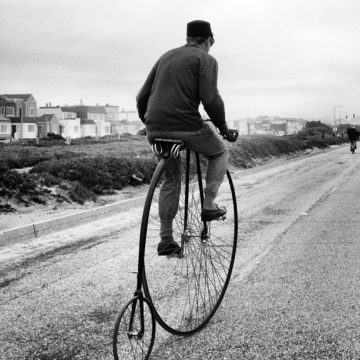 The bicycle, as we know it today, was not invented until the late 1800s. Yet it was a simple mechanical invention. It would seem to require no brilliant inventive insight, and certainly no scientific background.
The bicycle, as we know it today, was not invented until the late 1800s. Yet it was a simple mechanical invention. It would seem to require no brilliant inventive insight, and certainly no scientific background.
Why, then, wasn’t it invented much earlier?
I asked this question on Twitter, and read some discussion on Quora. People proposed many hypotheses, including:
More here.
Ussama Makdisi in Aeon:
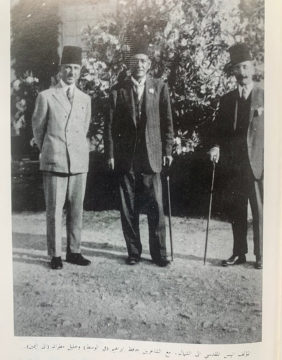 My paternal grandfather Anis was born an Ottoman subject in 1885 but died an Arab citizen. He passed away in 1977 at the age of 92, two years into Lebanon’s civil war. Raised in Tripoli when all the Arab East lay under Ottoman sovereignty, and educated in American mission schools that dotted the Empire in its last century, Anis Khoury Makdisi became a distinguished professor of Arabic at the American University of Beirut. Best known for his works on Arabic literature, he was known as ‘Ustadh Anis’ – a teacher of generations of students of Arabic in the Middle East’s most renowned modern university. He was also a proud member of the Arabic language academies of Cairo and of Damascus, institutions that embodied a modern age of coexistence that shaped the Arab Muslims, Christians and Jews of my grandfather’s generation.
My paternal grandfather Anis was born an Ottoman subject in 1885 but died an Arab citizen. He passed away in 1977 at the age of 92, two years into Lebanon’s civil war. Raised in Tripoli when all the Arab East lay under Ottoman sovereignty, and educated in American mission schools that dotted the Empire in its last century, Anis Khoury Makdisi became a distinguished professor of Arabic at the American University of Beirut. Best known for his works on Arabic literature, he was known as ‘Ustadh Anis’ – a teacher of generations of students of Arabic in the Middle East’s most renowned modern university. He was also a proud member of the Arabic language academies of Cairo and of Damascus, institutions that embodied a modern age of coexistence that shaped the Arab Muslims, Christians and Jews of my grandfather’s generation.
More here.
Elizabeth Kolbert in The New Yorker:
 This story begins about two billion years ago, when the world, if not young, exactly, was a lot more impressionable. The planet spun faster, so the sun rose every twenty-one hours. The earliest continents were forming—Arctica, for instance, which persists as bits and pieces of Siberia. Most of the globe was given over to oceans, and the oceans teemed with microbes.
This story begins about two billion years ago, when the world, if not young, exactly, was a lot more impressionable. The planet spun faster, so the sun rose every twenty-one hours. The earliest continents were forming—Arctica, for instance, which persists as bits and pieces of Siberia. Most of the globe was given over to oceans, and the oceans teemed with microbes.
Some of these microbes—the group known as cyanobacteria—had mastered a peculiarly powerful form of alchemy. They lived off sunlight, which they converted into sugar. As a waste product, they gave off oxygen. Cyanobacteria were so plentiful, and so good at what they did, that they changed the world. They altered the oceans’ chemistry, and then the atmosphere’s. Formerly in short supply, oxygen became abundant. Anything that couldn’t tolerate it either died off or retreated to some dark, airless corner. One day, another organism—a sort of proto-alga—devoured a cyanobacterium. Instead of being destroyed, as you might expect, the bacterium took up residence, like Jonah in the whale. This accommodation, unlikely as it was, sent life in a new direction. The secret to photosynthesis passed to the alga and all its heirs.
A billion years went by. The planet’s rotation slowed. The continents crashed together to form a supercontinent, Rodinia, then drifted apart again. The alga’s heirs diversified.
One side of the family stuck to the water. Another branch set out to colonize dry land. The first explorers stayed small and low to the ground. (These were probably related to liverworts.) Eventually, they were joined by the ancestors of today’s ferns and mosses. There was so much empty space—and hence available light—that plants, as one botanist has put it, found terrestrial life “irresistible.” They spread out their fronds and began to grow taller. The rise of plants made possible the rise of plant-eating animals. During the Carboniferous period, towering tree ferns and giant club mosses covered the earth, and insects with wingspans of more than two feet flitted through them.
More here.
Iman Ghosh in Nautilus:
 Our planet supports approximately 8.7 million species, of which over a quarter live in water. But humans can have a hard time comprehending numbers this big, so it can be difficult to really appreciate the breadth of this incredible diversity of life on Earth. To fully grasp this scale, we draw from research from “The biomass distribution on Earth,” by Yinon M. Bar-On, Rob Phillips, and Ron Milo to break down the total composition of the living world, in terms of its biomass, and where we fit into this picture.
Our planet supports approximately 8.7 million species, of which over a quarter live in water. But humans can have a hard time comprehending numbers this big, so it can be difficult to really appreciate the breadth of this incredible diversity of life on Earth. To fully grasp this scale, we draw from research from “The biomass distribution on Earth,” by Yinon M. Bar-On, Rob Phillips, and Ron Milo to break down the total composition of the living world, in terms of its biomass, and where we fit into this picture.
Why Carbon?
A “carbon-based life form” might sound like something out of science fiction, but that’s what we and all other living things are. Carbon is used in complex molecules and compounds—making it an essential part of our biology. That’s why biomass, or the mass of organisms, is typically measured in terms of carbon makeup. In our visualization, one cube represents 1 million metric tons of carbon, and every thousand of these cubes is equal to 1 Gigaton (Gt C). Here’s how the numbers stack up in terms of biomass of life on Earth:
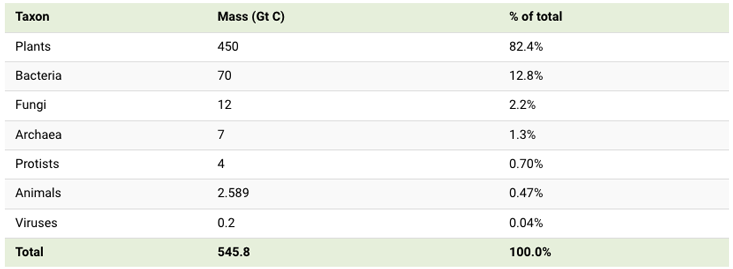
Plants make up the overwhelming majority of biomass on Earth. There are 320,000 species of plants, and their vital photosynthetic processes keep entire ecosystems from falling apart. Fungi is the third most abundant type of life—and although 148,000 species of fungi have been identified by scientists, it’s estimated there may be millions more.
More here.
Rosanna Warren at Salmagundi:
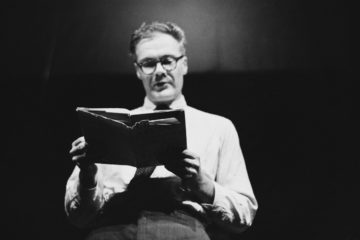 Robert Lowell is, for me, the inescapable elder poet, and Day by Day is the inescapable book. It is where you go if you want to see where American poetry last set into major balance an art fully aware of its traditions and an experimental openness to unliterary raw material. Leaving behind the ruck and rubble of Notebook and History, it steps beyond the Cyclopean masonry blocks of the unrhymed sonnets of The Dolphin and ventures into irregular but adamantine shapes of feeling and thought. The smashed sonnets may suggest the smashed life or lives the book loosely recounts: aging friends, dead friends, dead parents, are summoned; a marriage is chronicled in its dilapidations; mental breakdown sends the suffering speaker once again to a hospital. From these wreckages and from the wreck of stricter verse form, Lowell has saved the aphoristic essentials, and broken through to poetic renewal in the very recognition of failure. Sacrifice, truly executed, earns recompense, and these poems do.
Robert Lowell is, for me, the inescapable elder poet, and Day by Day is the inescapable book. It is where you go if you want to see where American poetry last set into major balance an art fully aware of its traditions and an experimental openness to unliterary raw material. Leaving behind the ruck and rubble of Notebook and History, it steps beyond the Cyclopean masonry blocks of the unrhymed sonnets of The Dolphin and ventures into irregular but adamantine shapes of feeling and thought. The smashed sonnets may suggest the smashed life or lives the book loosely recounts: aging friends, dead friends, dead parents, are summoned; a marriage is chronicled in its dilapidations; mental breakdown sends the suffering speaker once again to a hospital. From these wreckages and from the wreck of stricter verse form, Lowell has saved the aphoristic essentials, and broken through to poetic renewal in the very recognition of failure. Sacrifice, truly executed, earns recompense, and these poems do.
more here.
Devika Girish at The Current:
 A pair of kohl-lined eyes bores through the screen in the first few moments of Satyajit Ray’s Devi (1960), as the blank visage of a clay idol of Goddess Durga—held in close-up behind the opening credits—acquires bold, painted features. In Hindu myth, Durga and her wrathful avatar, Kali, are both forms of Devi, the all-powerful Mother Goddess. When the camera pulls away from the idol to reveal a village celebration of Durga Puja, the melodic strings of the score giving way to the diegetic din of bells and fireworks, it’s as if the legend of the Mother Goddess has been reified: the world has come into boisterous being around her.
A pair of kohl-lined eyes bores through the screen in the first few moments of Satyajit Ray’s Devi (1960), as the blank visage of a clay idol of Goddess Durga—held in close-up behind the opening credits—acquires bold, painted features. In Hindu myth, Durga and her wrathful avatar, Kali, are both forms of Devi, the all-powerful Mother Goddess. When the camera pulls away from the idol to reveal a village celebration of Durga Puja, the melodic strings of the score giving way to the diegetic din of bells and fireworks, it’s as if the legend of the Mother Goddess has been reified: the world has come into boisterous being around her.
The scene is both an anomaly in Ray’s work, with its gothic shadings, and a kind of signature shot. Often in the Bengali auteur’s lyrical, literary films, a set of curious eyes leads us into a world, and into a nascent point of view. Think of our introduction to Apu in Pather Panchali (1955), Ray’s triumphant debut feature and the first entry in The Apu Trilogy: Apu’s sister, Durga, pries one of his eyes open through a hole in his blanket to wake him up for school.
more here.
“It’s here, it’s gone. That’s it.”
…………..—Yacob Stručnost
It’s true, I’m getting ready to leave you.
You’re big and cold and expensive, and like any old lover,
I’ve begun to badmouth you to friends.
Once you were the center of my expanded life,
full-skirted host to my largesse. Display case
for dead aunt breakfronts and thrift store taste.
A cool backyard of Japanese maple and pine,
four types of hydrangea, and family close by. Come in, come in—
I’d coo to neighbors, meter readers, college friends
out from the city. Sorry it’s a mess, though I’d swept
through your rooms like a hurricane. Twice I held
Thanksgiving here, that deadly sin of pride,
and thirty chairs etched scars on your floors.
Now the dining room sits empty. The staircase quiet.
The gaudy bills pile up and the flooding
holds us under. Soon someone else will sit out back
on jasmine evenings, share a cigarette and two fingers
of good whiskey while the kids fall asleep, compare
your century-old body to a big bucket of cream.
by Theresa Burns
from Plume Magazine
Sam Thorne at Frieze:
 Paul Auster, Aldous Huxley, Thomas Mann, Susan Sontag, John Updike, Oscar Wilde and Virginia Woolf – many novelists who have written about fictional artists have also produced criticism. Indeed, one of the great novels of the 20th century, Marcel Proust’s In Search of Lost Time, began life as a work of criticism, a series of essays arguing against the author Sainte-Beuve. This voluminously chatty work is, over the course of its 1.5 million words, peppered with the names of more than 100 real-life artists – from Giotto and Corot, to Bellini and Léon Bakst. By my rough estimate, Vermeer and Whistler are the most frequently referred to, though much dinner party gossip is given over to Édouard Manet’s 1863 painting Olympia (‘Nowadays nobody is in the least surprised by it. It looks just like an Ingres!’ exclaims a duchess). Amidst the masters mingle Proust’s contemporaries – little-known or forgotten academicians, as well as critics and collectors – above whom towers just one fictional artist: Elstir, a famed painter whose seascapes, according to the narrator Marcel, ‘break up that medley of impressions which we call vision’. Many have tried to identify the source of Carquethuit Harbour, which is said to be Elstir’s greatest painting: Manet’s Le Port de Bordeaux (1871) is often mentioned, along with Vuillard and Hokusai, while Michel Butor has pointed out that ‘Elstir’ is a Gallicized anagram of ‘Whistler’.
Paul Auster, Aldous Huxley, Thomas Mann, Susan Sontag, John Updike, Oscar Wilde and Virginia Woolf – many novelists who have written about fictional artists have also produced criticism. Indeed, one of the great novels of the 20th century, Marcel Proust’s In Search of Lost Time, began life as a work of criticism, a series of essays arguing against the author Sainte-Beuve. This voluminously chatty work is, over the course of its 1.5 million words, peppered with the names of more than 100 real-life artists – from Giotto and Corot, to Bellini and Léon Bakst. By my rough estimate, Vermeer and Whistler are the most frequently referred to, though much dinner party gossip is given over to Édouard Manet’s 1863 painting Olympia (‘Nowadays nobody is in the least surprised by it. It looks just like an Ingres!’ exclaims a duchess). Amidst the masters mingle Proust’s contemporaries – little-known or forgotten academicians, as well as critics and collectors – above whom towers just one fictional artist: Elstir, a famed painter whose seascapes, according to the narrator Marcel, ‘break up that medley of impressions which we call vision’. Many have tried to identify the source of Carquethuit Harbour, which is said to be Elstir’s greatest painting: Manet’s Le Port de Bordeaux (1871) is often mentioned, along with Vuillard and Hokusai, while Michel Butor has pointed out that ‘Elstir’ is a Gallicized anagram of ‘Whistler’.
more here.
Maddie Crum at the LARB:
 LUCILLE CLIFTON’S Generations, her only work of nonfiction amid a vast body of poetry, was published in 1976, before memoir ballooned into a commodified genre, including ghostwritten celebrity tell-alls.
LUCILLE CLIFTON’S Generations, her only work of nonfiction amid a vast body of poetry, was published in 1976, before memoir ballooned into a commodified genre, including ghostwritten celebrity tell-alls.
As the form took shape in America, it borrowed from existing literary genres. In Reading Autobiography, Sidonie Smith and Julia Watson highlight several, including the confessional, a poetic style in which personal experiences and traumas, often taboo, are revealed to challenge existing power structures, and the bildungsroman, the rags-to-riches arc of social assimilation and public achievement.
In 1845, Frederick Douglass published his account of slavery, using the first-person “I” to reposition himself as the narrator of his own oppression; a decade later, in 1855, P. T. Barnum published a memoir in the vein of today’s self-help narratives, The Life and Adventures of P. J. Barnum: Clerk, Merchant, Editor, and Showman with His Rules for Business and Making a Fortune, using the first-person “I” to profess his authority.
more here.
Justin E. H. Smith in his Substack newsletter, Hinternet:
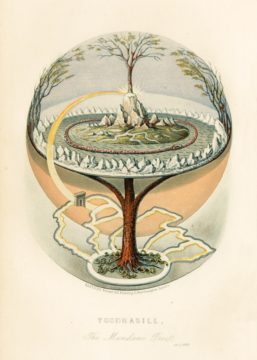 Just minutes after St. Nicholas was born, on December 6, he stood up on his own two feet in the basin where the midwives washed him, and completed the task himself. Then the babe grabbed a knife from the table and severed his own umbilical cord. Through the rest of his infancy he refused to nurse more than twice a week, and only ever on Wednesdays and Fridays. As Nicholas grew older he developed a sharp hatred of sin, and wept whenever he witnessed it. Having inherited a great wealth from his parents, he decided to fight sin through what you might today call “effective altruism”. When he overheard his neighbor announcing a plan to sell his two daughters into prostitution in order to lighten his debts, Nicholas contrived to throw a sack of gold coins through the neighbor’s window in the middle of the night (the sled and reindeer, we may imagine, are later accretions upon the legend). After a life of such good works, when he died in 313 AD, oil poured from his head, and water from his feet, and continued to pour for some centuries after that from the site of his burial, when such things as this still occurred.
Just minutes after St. Nicholas was born, on December 6, he stood up on his own two feet in the basin where the midwives washed him, and completed the task himself. Then the babe grabbed a knife from the table and severed his own umbilical cord. Through the rest of his infancy he refused to nurse more than twice a week, and only ever on Wednesdays and Fridays. As Nicholas grew older he developed a sharp hatred of sin, and wept whenever he witnessed it. Having inherited a great wealth from his parents, he decided to fight sin through what you might today call “effective altruism”. When he overheard his neighbor announcing a plan to sell his two daughters into prostitution in order to lighten his debts, Nicholas contrived to throw a sack of gold coins through the neighbor’s window in the middle of the night (the sled and reindeer, we may imagine, are later accretions upon the legend). After a life of such good works, when he died in 313 AD, oil poured from his head, and water from his feet, and continued to pour for some centuries after that from the site of his burial, when such things as this still occurred.
More here.
Emily Cataneo in Undark:
 Consciousness is such a slippery and ephemeral concept that it doesn’t even have its own word in many Romance languages, but nevertheless it’s a hot topic these days. “Feeling & Knowing” is the result of Damasio’s editor’s request to weigh in on the subject by writing a very short, very focused book. Over 200 pages, Damasio ponders profound questions: How did we get here? How did we develop minds with mental maps, a constant stream of images, and memories — mechanisms that exist symbiotically with the feelings and sensations in our bodies that we then, crucially, relate back to ourselves and associate with a sense of personhood?
Consciousness is such a slippery and ephemeral concept that it doesn’t even have its own word in many Romance languages, but nevertheless it’s a hot topic these days. “Feeling & Knowing” is the result of Damasio’s editor’s request to weigh in on the subject by writing a very short, very focused book. Over 200 pages, Damasio ponders profound questions: How did we get here? How did we develop minds with mental maps, a constant stream of images, and memories — mechanisms that exist symbiotically with the feelings and sensations in our bodies that we then, crucially, relate back to ourselves and associate with a sense of personhood?
Damasio argues that the answers are not simple (not so simple as an algorithm, anyway) but it’s also not as complex as some theorists and scientists believe.
More here.
Sayari Debnath in Scroll.in:
 Many readers around the world are still just discovering Abdulrazak Gurnah. After his winning the Nobel Prize for Literature in 2021 – which almost no one saw coming – the 72-year-old Zanzibar-born author is finally in the limelight that was perhaps due to him for a few decades now.
Many readers around the world are still just discovering Abdulrazak Gurnah. After his winning the Nobel Prize for Literature in 2021 – which almost no one saw coming – the 72-year-old Zanzibar-born author is finally in the limelight that was perhaps due to him for a few decades now.
Born in 1948, Gurnah spent his childhood in the islands of Zanzibar before escaping to England in the 1960s. This was shortly after the island gained independence from British colonial rule in December 1963 and went through a revolution. However, the post-revolution regime ushered in the oppression and persecution of citizens of Arab origin.
At the height of the civil unrest, massacres became a common occurrence on the island. Gurnah belonged to a persecuted minority ethnic group and, after finishing school, was forced to leave his family and flee the country.
More here.